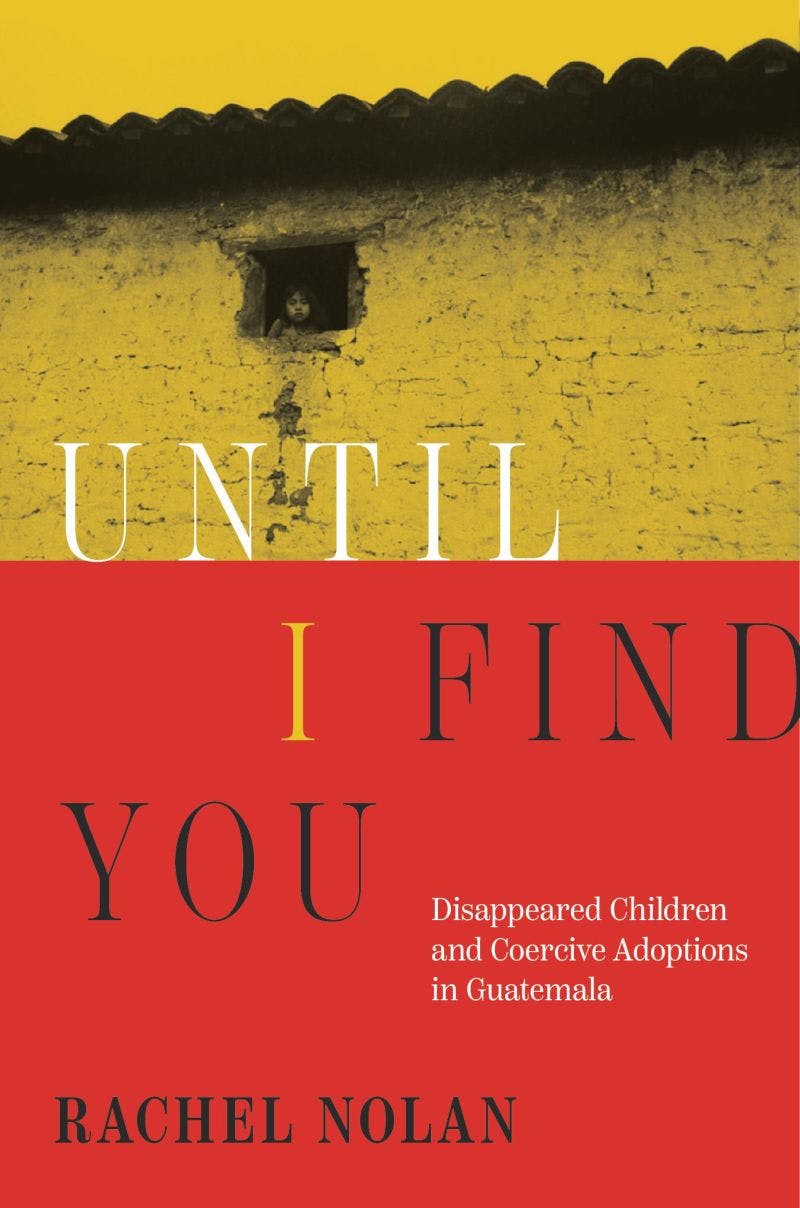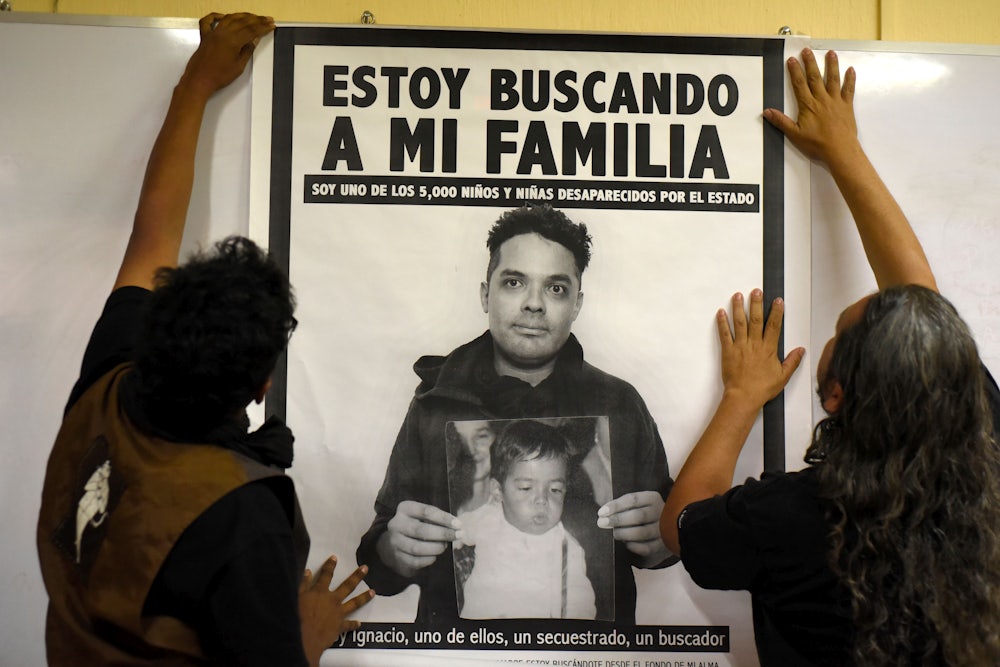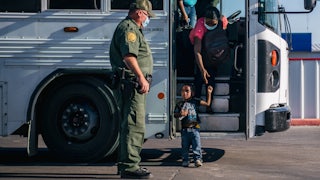The writer Francisco Goldman has said that Guatemala is a small country with big politics (paraphrasing Joseph Brodsky), while the United States is a big country with small politics. I kept thinking about this observation as I read Rachel Nolan’s deeply reported, sobering history, Until I Find You: Disappeared Children and Coercive Adoptions in Guatemala. Nolan’s story, in which soldiers steal children after killing their parents and a dictator’s sister-in-law is arrested for running an adoption ring, connects Cold War geopolitics, state repression, corruption, poverty, religion, and more. Meanwhile, the American presence in the narrative is largely one of blithe or willful ignorance of the conditions under which more than 40,000 Guatemalan children were sent abroad—29,807 of them to the U.S.—between 1997 and 2008, when Guatemala banned international adoptions. In 2007, one in 100 children born in Guatemala was adopted overseas.
At first, international adoptions in Guatemala went through state-run orphanages; then, after a massive earthquake in 1976 spurred coverage of an “orphan crisis,” Guatemala became the only country in the world to privatize adoptions, meaning lawyers could find children and match them with a prospective family, for a fee, with no judicial oversight. “This created an unregulated market for children based on foreign demand, and a strong and growing profit motive in Guatemala,” Nolan writes. “Some countries export bananas,” one lawyer said. “We exported babies.” Another likened the children to avocados.

The private system did not just place children who were already in state care. Prospective families often stated preferences of age or race, noted in adoption files. Lawyers, well-heeled, politically connected, and non-Indigenous, worked with jaladoras, or baby-brokers, to obtain children through a variety of legal or illegal means, including kidnapping. The jaladoras, usually women, carried photo albums showing the unimaginable luxuries of adoptive families’ homes, and would sometimes approach pregnant women on the bus or in the street to try to convince them that their child would be better off abroad.
Nolan is highly sensitive to the fact that the process tends to obscure the birth mother’s intentions. Adoption files and social workers’ or lawyers’ recollections make assumptions based on class and race, and can’t be read as a true reflection of the mother’s feelings. “In the best case,” Nolan writes, “jaladoras offered a way out for women with unwanted pregnancies.” But most of the birth mothers were Indigenous Maya, did not speak Spanish, and signed their children over with a thumbprint because they couldn’t write. Many of them were domestic workers, and the pregnancies often resulted from rape. They were almost all desperately poor: One woman told a journalist she got $40 and bus fare from a jaladora. The adoptive parents paid $25,000 for the private adoption. What does consent mean, Nolan asks, “under conditions of grinding poverty?”
The woman in the files wasn’t always the real birth mother, given rampant fraud and falsification of documents. Informal arrangements where children were placed with relatives or neighbors for a while were common in Guatemala, and the birth mothers may not have understood that with an international adoption, they wouldn’t get their child back. Nolan finds countless examples where the coercion of a birth mother is fairly explicit, or where a parent’s objections to the adoption were simply overruled by the social worker. “Even if she is her mother, she hasn’t known how to be a mother or love her. Even today she asks for her back, but without showing that missing her little girl has her depressed,” one social worker wrote. Another file stated the mother “appeared very TEARFUL, VERY TORMENTED, ASHAMED, but she recognizes that her decision will FAVOR HER CHILDREN.”
“Guatemalans tend to tell it as a story of corruption rather than mass terror,” Nolan writes, but in fact, the adoption industry included both. The abortion boom years coincided with Guatemala’s armed conflict between 1960 and 1996, when the state brutally suppressed a small leftist insurgency along with many thousands of others who had nothing to do with the opposition to Guatemala’s right-wing regimes. According to later truth commissions, 200,000 people died. Government forces were found responsible for 93 percent of the documented human rights violations. Eighty-three percent of those killed were Indigenous. A former dictator, Efraín Ríos Montt, was found guilty of genocide in 2013, and adoption files were among the evidence—not of a “concerted plan to use adoptions to cover war crimes,” Nolan writes, but of “a consistent pattern of separating Maya children from their families and communities, assigning them non-Maya names, and giving them in adoption to non-Indigenous Guatemalan or foreign families.” Adoptions were “part of a genocidal outcome.”
An emblematic case involves a child adopted in 1987 from a K’iche’-speaking town called Santa Lucía Utatlán via a private lawyer who frequently worked there. The father had died of malnutrition; the mother was a domestic servant. In 1978, a North American priest inspired by Liberation Theology had come to the town and helped the villagers set up an agricultural cooperative. The army declared it proto-Communist and “unleashed scorched earth campaigns that destroyed corn and bean crops.” They carried out extrajudicial murders and forced the cooperative to disband. The area “plunged into extreme poverty.” The lawyer’s file says merely that the town is “impoverished,” as justification for the adoption.
But behind that impoverishment, Nolan explains, is “U.S.-backed state terror.” In 1954, the CIA backed a coup against Guatemala’s democratically elected president, Jacobo Árbenz, a social democrat whose attempts at agrarian reform had convinced the U.S. government that he was a crypto-Communist. The military dictatorship installed after the coup enjoyed U.S. support even as evidence of atrocities emerged during the war. Interestingly, Nolan notes that the coup also led to changes in the country’s adoption code, including the removal of a clause saying that “a lack of economic resources is not considered sufficient reason to separate a minor from his parents.”
During the darkest period of state terror, in the early 1980s, children fled or were left behind at the scenes of horrific massacres; soldiers sometimes adopted them as “pets” to run errands or shine shoes on military bases, while others were dropped at orphanages or were likely handed over for private adoptions. In a case uncovered by ProPublica in 2012, a boy was kidnapped and brought to the U.S. by one of the Army lieutenants who participated in a massacre of 250 people in his village. The army sometimes sent workers from the Ministry of Social Welfare to pick up children after military operations in remote areas, in what were called “humanitarian” missions. “Disappearing children was a war crime that hid in plain sight, in the sense that some military officials openly bragged about ‘saving’ children,” Nolan writes. It is estimated that 500 forcibly disappeared children were put up for adoption. This is likely an undercount, because many people, especially many Indigenous people, never testified to the country’s two truth commissions, which were carried out soon after the peace accords. Shame and guilt may have also made families reluctant to report a lost or stolen child, or terror—one can imagine that the survivor of an army attack might be afraid to approach a state-run orphanage to search for their child.
As in “orphan-rescue missions” from Germany and Japan after World War II and “Operation Babylift” after Vietnam, adoptions were seen from abroad as a humanitarian effort, “private, and somehow apolitical,” though, Nolan notes, they were always “very much part of great power politics.” The U.S., through its support of successive Guatemalan regimes, helped create the conditions that led to the children being given up for adoption. More specifically, the U.S. Embassy, which awarded exit visas for adoptees, was aware of crime in the adoption system as early as 1988. Yet officials were more concerned with the complaints they got from American adoptive parents, who badgered the Embassy and congressmen when their cases slowed. The “urgency of parenting instincts of the relative wealthy Americans,” in the words of a 1989 Embassy cable, was a pressing factor. Ironically, American families sometimes expressed on their adoption forms “humanitarian concern for the war-torn nation of Guatemala as one reason for their wish to adopt.”
Nolan obtained access to previously untapped archives of the Guatemalan Ministry of Social Welfare, which held files on children adopted through the central state orphanage, and, for a window into private adoptions, the files of a Trump-supporting Guatemala City lawyer who professes to be undertaking his own investigation into how foreign adoptions were banned, at the “alternative cost,” he believed, of “kids out on the street as burglars and prostitutes.” (This is an academic book, but Nolan’s journalistic flair comes out in her encounters with the lawyers, one of whom she meets in a jail cell filled with cats.) Out of respect for privacy, she does not reveal real names, nor did she contact any of the people in the files she read. This was obviously the ethical choice, but it’s agonizing to wonder what happened to those children flown around the world. I also wanted to learn more about the foreign side of the adoption industry. We get just a bit of it: mentions of a corrupt lawyer “working on commission for a Florida-based adoption agency”; an American couple who flatly refuse to return a child even after eight people were convicted for being involved in her kidnapping; and Christian organizations that had connections with evangelical relief agencies and missionaries. Nolan finds “adoption files were thick with expressions of faith.”
Nolan does connect with adoptees searching for their birth parents in the book’s epilogue (as she did in a story she published in Harper’s in 2019), who are part of “a wave of adult adoptees returning to Guatemala.” They have formed mutual support organizations to help reunite families and pressure the government, in concert with the country’s slow and difficult unearthing of genocide and other political violence. Some former jaladoras now work as “searchers” for adoptees looking for their parents; one reported being paid $1,000 per case. The efforts of those adoptees are part of the reevaluation of adoptions, as explored in a recent piece in The New Yorker, which noted the emotional and psychological impacts of transracial and international adoptions in particular. “Sender” countries like Romania and Ethiopia have banned international adoptions. After waves of public outrage—including unfounded rumors in the 1990s that children were being trafficked for their organs, which led to mob killings of foreigners—Guatemala did the same.
Today Guatemalan children are still separated from their parents in a foreign country, but now it happens at the U.S. border. An A.P. investigation in 2018 found that state court judges had granted “custody of migrant children to American families without notifying their parents.” One of the many maddening things about immigration policy in recent administrations, Democratic and Republican alike, is the way U.S. officials scold migrants for putting their children in danger, as though it wasn’t danger that forced them to migrate in the first place. It’s very like the ideas about “good mothers” and “bad mothers” that colored Guatemalan adoption files. Nolan cites a 2009 case where a 1-year-old Guatemalan was allowed to stay with a North American family; of her mother, who had been arrested in a U.S. Immigration and Customs Enforcement raid in Missouri, the judge said, “smuggling herself into the country is not a lifestyle that can provide any stability for the child.”
More often, however, Guatemalan children are unwanted in the U.S. The “orphan crisis” has been supplanted by a “migrant crisis.” Instead of the adoption process, trauma and poverty are now filtered through the asylum process, which also does a poor job of attending to individual and sociohistorical circumstances and the U.S. role in them. In her 2017 book Tell Me How It Ends, the Mexican novelist Valeria Luiselli describes working with a nonprofit, screening Central American children seeking asylum. Each interview she did, she writes, was “a snapshot of a life that will wait in the dark until maybe someone finds it and decides to make it a case.” The injustices Nolan found in musty adoption files are happening to children now. It shouldn’t take decades for our reckoning with it.






